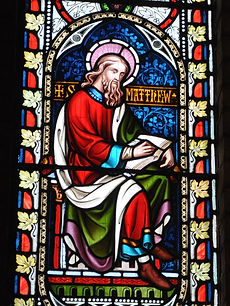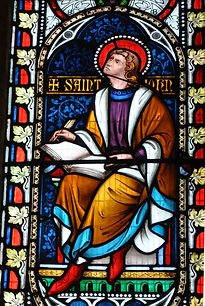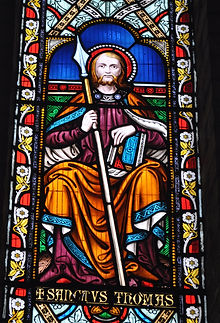RAMSEY & PONDERSBRIDGE
RAMSEY : CHURCH OF ST THOMAS A BECKET
Church Post Code PE26 1DW
Usually open to visitors
Ramsey is a town of roughly 8,000 people which can be found approximately 13 miles to the south east of Peterborough. The town that we know today grew up around Ramsey Abbey, a Benedictine Monastery, which was first built in 969AD before being rebuilt in Barnack stone between 1116 and 1154.
The church of St Thomas A Becket stands close to the ruins of the Abbey gatehouse, against a large green, set back a little from the busy shopping area of the town. This is a very pleasant area, with a large pond off to the north of the church.
I have made a few visits to the church at Ramsey over the years and have some fond memories of my times there. My first visit was on a very unseasonably warm and humid late Autumn day, with the large and interesting church grounds absolutely covered in spiders webs!
There are good memories also of a bus rally, a few months before covid hit, where I spent a very pleasant time with friends from church; sitting outside the church with a packed lunch attempting, unsuccessfully, to get a decent shot of an old red rout master bus driving past the church.


This church that we see today started off life as a hospital, or a guest house for pilgrims, with this being founded around 1180. At that time, the faithful of Ramsey would have worshiped in the nearby Abbey. It is thought that the present day church was consecrated in 1238. Also, according to the informative church history booklet that was available, the tower is much younger than the rest of the church, being built in 1672 and was built from stone taken from the Abbey ruins. There is an inscription just above the main door on the West side of the tower which reads "Take heed, watch and pray, for ye know not when the time is"
At one point there was a small wooden steeple to be seen here. This was built in the late 1530’s but fell down during the 17th century.
The church here consists of west tower, nave with north and south aisles and clerestories and chancel. There is a door to the south but the main entrance is through a doorway at the west of the tower. Both north and south aisles come out level with the western edge of the tower.



Approaching the church from the west, this church is beautifully perpendicular. The structure is buttressed throughout with the tower and aisles pinnacled. A clock in the traditional colours of blue and gold is attached to the west and north faces of the tower.
The church here was closed on my first visit here; but several visits since has seen the church open on each occasion. This page is being re written during December of 2021 and I have not been to this church since covid began; therefore I am not sure what the situation is regrading opening at present.
This is a lovely church to look around. Really peaceful and calm! There was a lady cleaning inside when I was there. She had the vacuum out and was attentive to the people around here; turning off the vacuum as I sat down just to have a quiet couple of minutes, even though the noise wasn’t bothering me. Sometimes the little things stick in to the mind. Little pieces of thoughtfulness certainly do!


The nave is of seven bays to north and south, with the westernmost bay interrupted by the tower. There is a lot of stained glass here; nothing of any great age and much of it being early 20th century, from Morris and Co.
The east window consists of three single light windows with a smaller arched panel above. The panel above depicts Christ in majesty, crowned and with hand raised in blessing, holding a globe and with angels milling around His feet.
Central of the three panels below is the Virgin Mary, carrying lilies, a symbol of purity. To either side of her are angels, each with vivid blue wings, each of who is carrying but not playing a musical instrument.
A nativity scene close by sees Mary cradling the baby Jesus. The two are watched over intently by two angels, again who have blue wings. The shepherds are there, but off in the background a little and there is no sign of Joseph at all. On another panel an angel appears to the Virgin Mary and Mary Magdalene outside Jesus’ tomb on Easter morning, ‘He is not here but is risen’.





Some smaller panels are of interest, with two of them involving Saints who have local connections . One depicts St Athelreda, who was a Fenland queen and Abbess of Ely. Next to her is a fairly graphic detailing of the assassination of St Thomas A Becket, after whom this church is dedicated.
Next to this is a panel to St Felix, with scenes from the life of the first Bishop of the East Angles. He is thought to have introduced Christianity to East Anglia; he died in or around 648AD and his relics ended up at Soham. The shrine here was desecrated by the Vikings and his remains were recovered and returned to Ramsey Abbey where they were buried.
As is often the case, it is worth looking upwards, to small figures up in the tracery; here there being some figures playing musical instruments whilst others hold shields on which are written ‘Purity, Constancy, Courage, Faith, Self Sacrifice and Wisdom’, the six attributes of courage.



There is conjecture as to the age of the font. This font is hexagonal and one historian has said that it could be earlier in date than any part of the existing church. Pevsner, however, dates it as 13th Century. At one point the font was disused and was buried under the floor. It was restored in early Victorian times. I was interested to see in the history booklet that the organ here was built in 1903 at a cost of £250. It was restored just under 100 years later at a cost of a mere £45,000!!
Six bells hang here with all six being cast by Robert Taylor in 1810. Two of these have inscribed the names Thomas Pooley and Henry Parker, the church wardens of the day. Four bells were hanging here at the time that the wooden steeple fell. When the tower was built a fifth was added and I am assuming that a sixth was added in 1810, with the other five possibly being re-cast at that time. Making my way back out, there is a nice stained glass depiction of Jesus with children over the west door.



The church grounds here have some of the most interesting and important gravestones to be found within the catchment area of this site. Several feature the deaths head, the human skull symbolising the mortality of Man. A message to the onlooker that you will go the same way as the deceased, so live a good Christian life, so that you don’t get caught short when your own time comes. As the plaque on the west wall of the tower states ‘Take heed, watch and pray, for ye know not when the time is’.
Some of the carvings here are of exceptional quality. Two cherubs lift a crown between them, with each pointing a finger upwards towards Heaven. The crown symbolises victory, with the victory here being over death. A similar scene sees the cherubs blowing a trumpet; an often used symbol of the resurrection. The deceased has lived a good life and will be resurrected on the final day.



A lovely church in a picturesque setting, with a wealth of history! As I said earlier, I am not sure if the church here is open to visitors post covid but if you can see inside this one, it would be well worth the effort! The photographs on this page are from two different visits to this church.
PONDERSBRIDGE : CHURCH OF ST THOMAS
Church Post Code PE26 2TR
Check with church re: opening


It was the start of Holy Week 2016, Palm Sunday with David and myself attending an evening prayer at the church of St Thomas at Pondersbridge. Pondersbridge is a small village in the Cambridgeshire Fens; with Whittlesey around three miles to the north, Yaxley and Farcet four and a half miles to the west and North West respectively and Ramsey five miles away to the south. Looking to the east there is little or nothing except a patchwork of flat Fenland fields until you reach March some 16 miles away. The name is thought to mean a bridge at the place of the followers of Ponder and in the mid 19th century it is called Pond’s Bridge on maps.
The village itself is built along the banks of Bevills Leam a Fenland Waterway which helps with drainage for the low lying farmland. And it’s cold! My goodness it is cold and exposed here; my late father was a Fenman and he always said that you have to be tough to live in the Fens!
The church here is central in the village and was built in 1869, replacing an earlier structure. This is a church of some size, but is pretty much a single cell unit albeit with a south transept. The east end of the church curves around in an apse. There is a small bell cote rising up at the North West corner, which contains a single bell which is without a founders name but which was cast in 1870.



In doing a little research for this page, Pondersbridge is one of the churches listed on English Heritage’s At Risk Register due to structural issues, with the report dated to January 2024. The report states that there are issues with damp and plant growth with structural movement causing problems. The report ended by saying that the overall condition of the church was poor, with slow decay, and no solution proposed at the time of the report.
It was great to find the church open, and moving inside it was warm and welcoming with the stove lit against the south wall. Moving in to the chancel the altar cloth was red, which is the liturgical colour used in Holy Week on Palm Sunday and Good Friday; the reredos depicts the Agnus Dei, the Lamb of God, central flanked by four angels playing musical instruments, each under a trefoil arch, produced in mosaic form.


The east window consists of three trefoil shapes, with Christ in majesty central, hand raised in blessing and holding a globe; wearing a red cloak and with a red and white nimbus, symbolic of his blood shed. This depiction is flanked by small roundels containing the Alpha and the Omega, the beginning and the end, with two golden haired angels wielding censers below, with one further roundel containing the Holy Spirit in the form of a dove below these. Text across the reredos reads ‘The Word Was Made Flesh’.
Also in the chancel we have four single light depictions of the four Gospel writers with one further single light window of St Thomas (Doubting Thomas) after who the church is dedicated. Thomas is seated and staring directly ahead at the onlooker; carrying a spear which denotes the manner of his martyrdom; Christian legend from the Acts of Thomas states that he was killed by a spear in India.






The people were friendly and welcoming and we were given an invite to back to a bonfire which was to be held later that week. It was a pleasant evening and I made myself comfortable by the stove with a friend made during the evening, and stayed there quite happily until it was time to leave.
It was a brief, but happy stay here. It is sad to hear of the structural issues affecting this church in the years since David and I visited and trust that things will improve in the future. Daylight was fading fast and it was time to head off back towards home.